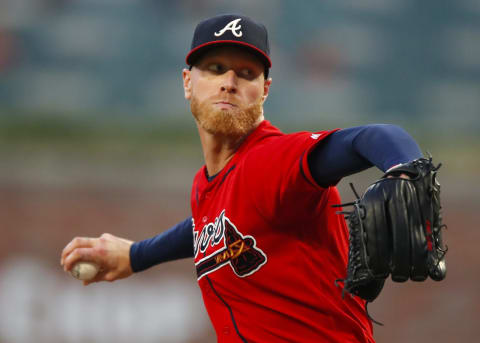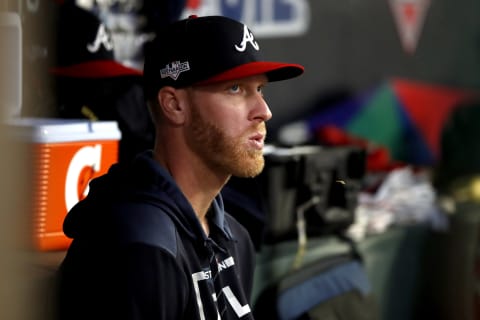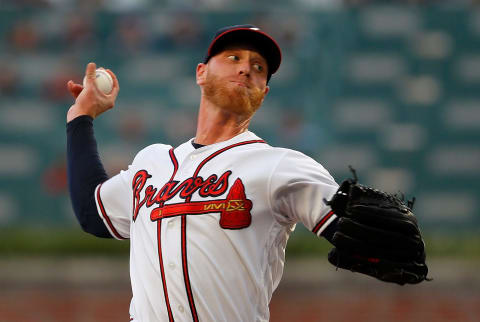Atlanta Braves Need Consistency from Mike Foltynewicz in 2020


Mike Foltynewicz’s last appearance for the Atlanta Braves was a horror show. Can the right-handed hurler turn 2020’s short season into a happy ending?
At this point in his Atlanta Braves tenure, you wouldn’t be wrong in slapping the enigma label on Foltynewciz’s career trajectory. The short spurts of tremendous output are often wrapped around fickle fits of an abysmal appearance or two.
Take for instance his final outing of 2019. If you’re in no mood to relive it, feel free to skip down a few paragraphs. I won’t blame you in the slightest.
In game five of the National League Division Series against the St. Louis Cardinals, Foltynewciz lasted just 23 pitches. By the time the right-hander limped off the mound in the decisive first inning, the Braves had seemingly packed up their lockers and situated themselves on the proverbial off-season couch in front of the TV.
Sure, Freddie Freeman booting a ground ball that could have transformed the play into a potential inning-ending double play didn’t help. But neither did Folty’s hapless performance. He allowed six earned runs on three hits with three walks, while recording just one out before being pulled for Max Fried. The Braves, of course, lost the game 13-1.
Mike Foltynewicz comments on his NLDS Game 5 start: pic.twitter.com/KyH4DqG46v
— Bally Sports: Braves (@BravesOnBally) October 10, 2019
Call it Helter Skelter. Call it a curious case of Jekyll and Hyde. Just call me when it’s consistent.
The stark contrast from start-to-start was highlighted in the earlier game two of the NLDS, when Folty outpaced Cardinals ace Jack Flaherty, recording seven shutout innings of three-hit ball, striking out seven without allowing a walk. His clutch performance helped tie the series at a game apiece. He was dynamic and direct with his pitches, and, when the Braves needed him the most (up to that point), dominating.
Yet, those two performances serve as a microcosm for Foltynewciz’s career in Atlanta. Let’s take a quick look, for reference, at his postseason career.
2018 NLDS against the Los Angeles Dodgers: 2 GS, 0-1, 7.50 ERA, 6 IP, 5 ER, 7 walks, 10 Ks
2019 against the Cardinals: 2 GS, 1-1, 7.36 ERA, 7.1 IP, 6 ER, 3 walks, 7 Ks
Much like his regular season month-to-month performances, the whole operation is manic.
He’s lights out, then he’s lit up. He tightens the screws, then he’s completely unraveled. He figures out the formula, then he’s entirely unsolvable.
As fans, we’re consistently teased with his talents. There is no doubt that Foltynewciz has the skill set to be a frontline starter. He has the mechanics, the velocity, and the movement to churn out commanding performances.
However, the speed humps, whether it be physical or mental, often prevent him from piecing together the jigsaw puzzle that is getting Major League hitters out on a consistent basis. He has unswervingly proven, when situations don’t pan out in his favor, to have shaken confidence (whether that’s through his visible animations on the mound after giving up a long ball or through the results on the stat sheet).
As we all know, Folty, an All-Star in 2018, hit rock bottom early in the 2019 season when he was demoted to Triple-A Gwinnett. After fine-tuning his mechanics down on the farm, his second-half sequel with the Braves recaptured most of what we saw from him two seasons ago.
Then, of course, that was all forgotten when he reverted back to his old foibles in his final appearance of the year.
But, before we proceed any further down this path of negativity — apparently, the wrong side of the bed is my side of choice (or so says my wife)— we need to get one thing crystal clear. Foltynewciz undeniably has the capacity to succeed at this level. That is not in question.
Dependability, however, is.
And that will be key for him within the abbreviated 2020 season.
Foltynewciz, who is 28-years-old and arbitration eligible in 2021, needs to prove to the Braves that he can be counted on every fifth day within a shortened schedule.

To determine how he can accomplish this and what we can expect from him in this unusual upcoming season, let’s first take a dive into what went wrong for Foltynewciz last season.
Let’s be honest. There is a lot to unpack as it relates to Foltynewciz’s 2019 season.
The season’s heavy lifting included a rehab stint in Gwinnett to start the season, a demotion to the minors following a poor performance in Atlanta, a resurgence of epic proportions in the second half, a stellar post-season start, and, of course, a not-so-stellar post-season start.
Before we can truly analyze the discrepancies of his erratic campaign, let’s take a snapshot of his full-season comparisons over the past two seasons (stats provided by FanGraphs) to gain a better understanding of what we’re dealing with here.
2018: 31 starts, 183 IP, 13-10, 2.85 ERA, 9.9 K/9, 3.3 BB/9
2019: 21 starts, 117 IP, 8-6, 4.54 ERA, 8.1 K/9, 2.8 BB/9
In 2018, Foltynewciz was a man on a mission. He was reliable, dominate, and, more so than anything else, unmistakably matured on the mound. In nearly half of his starts that season, he lasted at least six innings. Implementing his slider at a much more consistent rate to offset his powerful fastball, Foltynewciz registered a 27.2 percent strikeout rate to go along with a 3.39 FIP and a .251 BABIP.
In 2019, most everything went south from a statistical standpoint. His strikeout percentage dropped to 21.49 percent (and his strikeouts per nine innings decreased to 8.08), his FIP ballooned to 4.97 and his BABIP jettisoned to .265.
Major League hitters were squaring him up at a much higher rate as well, with his line drive percentages (18.5 percent in 2018 to 23.1 percent in 2019) and hard hit percentages (35.1 percent to 40.3 percent) soaring. His ground ball rate also dived from 43.1 percent to 36.7 percent.
So, what was the difference?
His slider, for most of the season, just wasn’t as efficient. When Foltynewciz commands his slider, he has the makeup of a top-of-the-rotation starter. When the slider sits on the shelf, Major League hitters rarely miss.
In 2019, Foltynewciz’s velocity was also down across the board compared to 2018. His four-seam fastball decreased from 96.8 mph to 94.9 mph on average and his slider dipped from 87.2 mph to 85.5 mph. He was giving up more contact and less swings and misses than in his previous career-year.
What was the cause? Was it the elbow issues? As previously mentioned, his right arm flared up in spring training, forcing him to start the season rehabbing at Gwinnett.
When he returned to Atlanta, he was a shell of his former self, recording a 6.37 ERA in 11 starts (53.1 innings). He surrendered 16 home runs during that stretch, and was eventually optioned back down to Gwinnett.
As his progression goes, Folty was naturally much better in the minors, allowing just 10 earned runs and 27 hits in 33.2 innings, striking out 31 batters, while walking only eight and allowing only one home run.
When he was recalled by the Braves on August 5, he was reinvented. Atlanta won nine of Foltynewciz’s ten starts, and he allowed three runs only once during that stretch. He was 4-1 in September, had the impressive start against the Cardinals in game two of the NLCS, and, as discussed ad nauseam, simply fell apart in his final start of the year.

With all that being said, how does Foltynewciz’s chaotic output last season help shape the new season? Let’s find out what we can expect in 2020.
In spring training 1.0, Foltynewciz wasn’t exactly a pristine pitcher. In three starts, he went 0-1 with a 5.14 ERA in seven innings, giving up six hits and four earned runs.
But that was before the Earth stopped spinning on its axis and before my morning commute transformed into walking from my bedroom into my home office…but, I digress.
In the opening week of spring training 2.0, Alex Anthopoulos said Braves starting pitchers will be limited to three to four innings the first couple of times through the rotation. With (hopefully) plenty of depth this season, Brian Snitker will likely handle the pitching staff with kid gloves early on, utilizing fresh arms in key situations.
If there is positive to come out of the pandemic, from purely a baseball perspective, it’s that starting pitchers will have a lightened load.
In the Braves’ scrimmage on July 9, Foltynewciz tossed three near-perfect innings. He struck out three, allowed just one baserunner, and commanded a lineup that included Ronald Acuna Jr., Austin Riley and Marcell Ozuna.
It’s been reported that Foltynewicz was consistently throwing up to six times a week during the four-plus month layoff. He’s expected to make two more game-like appearances before the start of the season, and, if last week’s effort was any indication, coupled with his comments, he should only get stronger.
But there may not always be pressure to go deep into games. And Foltynewciz will absolutely benefit from that, as his track record proves.
For what’s it worth, with the DH going into effect in the National League, he also will not need to worry about hitting. Not that he ever has – he hit .057 last season with two hits in 35 at-bats. He’s a lifetime 0.70 hitter.
With a clear mindset (and a healthy arm), Foltynewciz can be every bit as successful as he proved to be in 2018. The opportunity to be an ace is still there – even if that chance is hanging by a dangling thread. It begins with maintaining emotions and ends with pitching consistently.
In the rotation, he should effectively slot behind both Mike Soroka and Max Fried. His performance becomes even more crucial should Cole Hamels’ arm issues continue to leave the veteran southpaw out of commission.
For projection’s sake for the 2020 season, we’ll be modest without relying too heavily on wishful thinking. Expect Foltynewciz to secure the third spot in the rotation, notching a respectable win-loss record of 4-3 in 60 innings with a 4.20 ERA. If he can figure out proper slider efficiency, the strikeout rate should also revert back to more realistic numbers (count on 54 strikeouts this season).
Next. Is Dansby Primed to Breakout in 2020?. dark
In a compacted season, Foltynewicz will need to reignite his skill set to mirror what we saw from him in the second-half of last season. What are your expectations for him in 2020? Let us know in the comments.